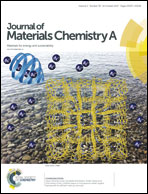Epitaxial encapsulation of homodispersed CeO2 in a cobalt–porphyrin network derived thin film for the highly efficient oxygen evolution reaction†
Abstract
Metal–organic frameworks (MOFs) containing rich transition metal ions and functional ligands have attracted interest for the non-noble metal oxygen evolution reaction (OER). However, the realization of MOF-based thin films for optimizing and improving electrocatalysis remains a significant challenge. In this work, we report a homodispersed CeO2 encapsulated cobalt–porphyrin network derived thin film by epitaxial encapsulation approach for optimizing and improving OER performance. The OER activity can be optimized effectively via tuning the thicknesses and calcination temperatures of the cobalt–porphyrin network PIZA-1 thin film. After loading a Ce(III) coordination compound into PIZA-1 by the epitaxial encapsulation method and calcination at 400 °C, a thin film of PIZA-1 derivative with homo-dispersed CeO2 was obtained successfully for greatly improved electrocatalytic OER performance (an overpotential of 370 mV at 10.0 mA cm−2). The work presented here will be extended to the fabrication of other composite thin film electrode materials for high electrocatalytic performance.



 Please wait while we load your content...
Please wait while we load your content...